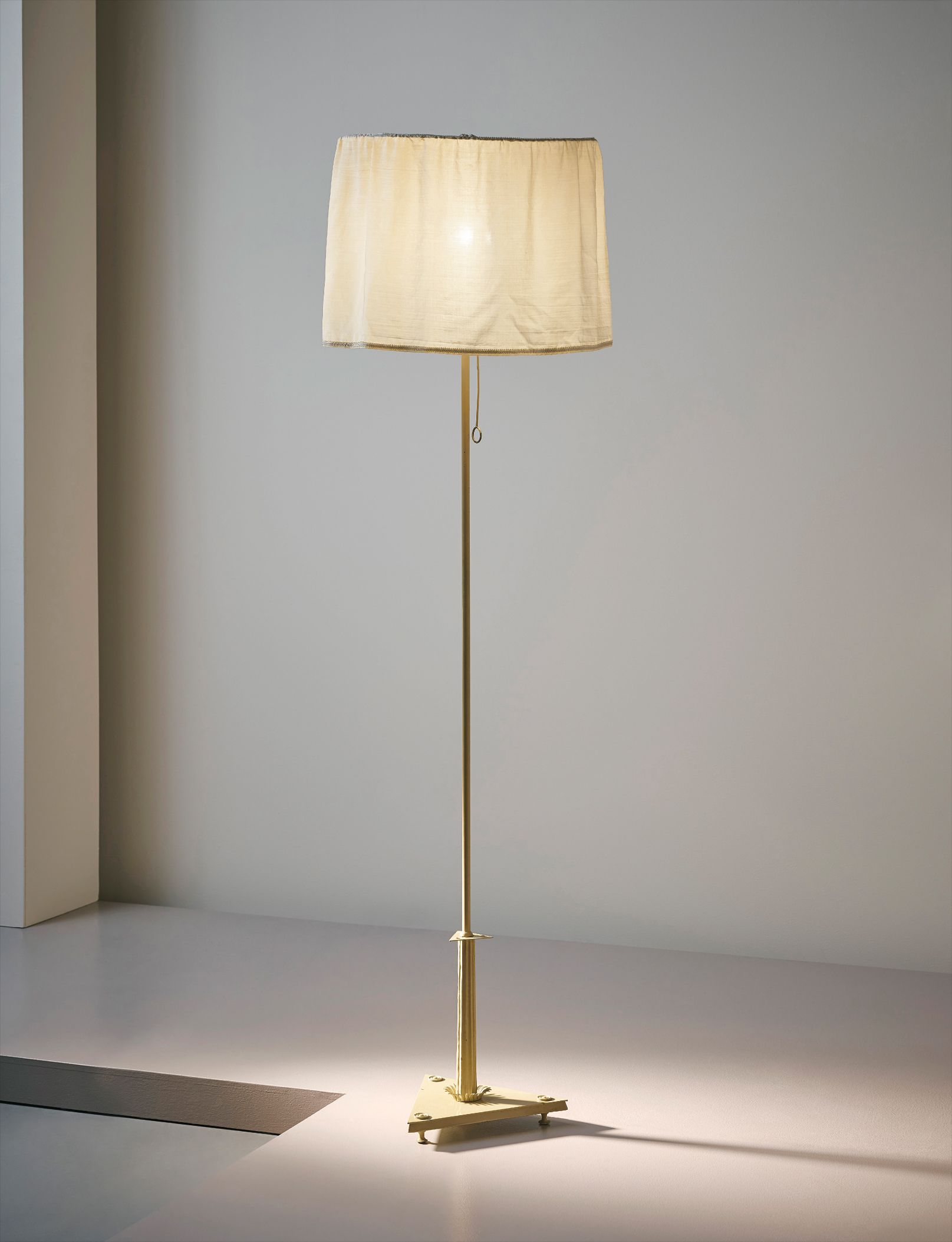

25
Erik Gunnar Asplund
Rare standard lamp
1920
Painted steel, painted tubular steel, fabric shade.
160.5 cm (63 1/4 in.) high
Full-Cataloguing
Swedish Grace
by Thomas Ekström
In the preface of his book The Architecture of Gunnar Asplund, 1980, Stuart Wrede notes that it is the first comprehensive book on Asplund since the 1940s. Today this seems surprising, though at the time, with society’s elevation of Modernism in architecture and city planning, Asplund’s work and impact was tacitly ignored. Few countries embraced Modernism and rejected history like Sweden did. Ignorance of Asplund’s genius, against other architects of the time, is summarised by the title of Colin St. John Wilson’s essay on the architect, Gunnar Asplund and the dilemma of classicism. Asplund’s masterpieces were prototypical of Swedish Grace; the Lister Courthouse, Stockholm City Library and the Skandia Cinema have decoration that makes them intrinsically Classical. Whilst Nordic Classicism and Swedish Grace evolved from Classicism, the dissolution of guidelines and tempering of proportions were truly progressive. Asplund’s masterworks can therefore be considered timeless rather than Classical.
The assiduity with which Asplund worked as an architect in the early 20th century is no secret; he regularly redrafted his projects from his small office with few employees. The architect’s competence and hard work is immediately noticeable upon entering his buildings. “To look at the plan is like reading music”, as Colin St John Wilson notes. Within Asplund’s buildings, the lighting, the furniture and the hardware was frequently designed by the same small team at his office, creating a total work of art.
At the time that the Verkstaden, a home arts and industries association, was founded in 1918, Asplund worked on several projects that became prominent in his oeuvre: Villa Snellman, the Woodland chapel and the Skandia Cinema. With the aim to introduce design and decorative art to a wider audience, the Verkstaden sought to create a ‘selling’ environment for each and every artist whose work was exhibited. Asplund created two rooms for the Verkstaden´s exhibition at Liljevachls konsthall in Stockholm in 1920, a lady’s room, and a music room, from where the present standing lamp originates. This standing lamp was manufactured by Böhlmarks and its production was limited.
Robert Berghagen, Swedish architect and admirer of Asplund’s work, had several pieces by the master in his own home. Amongst these was a hanging lamp, also designed in 1920, which is now in the collection of the Nationalmuseum, Stockholm.
by Thomas Ekström
In the preface of his book The Architecture of Gunnar Asplund, 1980, Stuart Wrede notes that it is the first comprehensive book on Asplund since the 1940s. Today this seems surprising, though at the time, with society’s elevation of Modernism in architecture and city planning, Asplund’s work and impact was tacitly ignored. Few countries embraced Modernism and rejected history like Sweden did. Ignorance of Asplund’s genius, against other architects of the time, is summarised by the title of Colin St. John Wilson’s essay on the architect, Gunnar Asplund and the dilemma of classicism. Asplund’s masterpieces were prototypical of Swedish Grace; the Lister Courthouse, Stockholm City Library and the Skandia Cinema have decoration that makes them intrinsically Classical. Whilst Nordic Classicism and Swedish Grace evolved from Classicism, the dissolution of guidelines and tempering of proportions were truly progressive. Asplund’s masterworks can therefore be considered timeless rather than Classical.
The assiduity with which Asplund worked as an architect in the early 20th century is no secret; he regularly redrafted his projects from his small office with few employees. The architect’s competence and hard work is immediately noticeable upon entering his buildings. “To look at the plan is like reading music”, as Colin St John Wilson notes. Within Asplund’s buildings, the lighting, the furniture and the hardware was frequently designed by the same small team at his office, creating a total work of art.
At the time that the Verkstaden, a home arts and industries association, was founded in 1918, Asplund worked on several projects that became prominent in his oeuvre: Villa Snellman, the Woodland chapel and the Skandia Cinema. With the aim to introduce design and decorative art to a wider audience, the Verkstaden sought to create a ‘selling’ environment for each and every artist whose work was exhibited. Asplund created two rooms for the Verkstaden´s exhibition at Liljevachls konsthall in Stockholm in 1920, a lady’s room, and a music room, from where the present standing lamp originates. This standing lamp was manufactured by Böhlmarks and its production was limited.
Robert Berghagen, Swedish architect and admirer of Asplund’s work, had several pieces by the master in his own home. Amongst these was a hanging lamp, also designed in 1920, which is now in the collection of the Nationalmuseum, Stockholm.